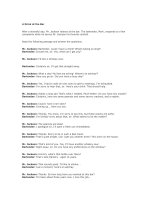NIH at the Crossroads: Strategies for the Future ppt
Bạn đang xem bản rút gọn của tài liệu. Xem và tải ngay bản đầy đủ của tài liệu tại đây (6.02 MB, 39 trang )
NIH at the Crossroads: Strategies for the
Future
Elias A. Zerhouni, M.D.
Director
National Institutes of Health
NIH Budget Facing a —Perfect
Storm“ in 2006
° Federal & Trade Deficits
° Defense and Homeland
Security needs
° Katrina
° Pandemic flu
° Post- Doubling effects
° Physical Sciences focus
° Biomedical research
inflation- 3 to 5%
Competition for funds from the NIH and other
sponsors, intensifying year by year, now stands
at an unprecedented level, and shows no sign of
abating. Never before have so many established
investigators faced so much uncertainty about
their longevity as active scientists. Never before
have so many novices faced so many
disincentives to entering or continuing a research
career.
Dr. William F. Raub, NIH Associate Director for
Research and Training, strategy paper, 1982
What Is Really Happening?
3 Fundamental Drivers
° Large capacity building
throughout U.S. research
institutions and increase in
number of new faculty
° Appropriations below
inflation after 2003
° Increases of 3 % in ”04, 2% in
”05 and 0% in 06
° Biomedical Inflation in 2004
was ~ 5%
° Budget cycling phenomenon
Investment in Research Facilities at
Dollars (in billions)
U.S. Medical Schools
10
9.5B
8
6
5.4B
4
3.2B
2
0
1990-1997 1998-2002 2003-2007
Year
AAMC œ Survey of Research Facility Investments (99 of 125 AAMC Member Schools)
*
Data Based on AAMC Faculty Roster
New Grant Applications, Applicants and
Success Rates
During and After Doubling Period
1998 1999 2000 2001 2002 2003 2004 2005 2006 2007
Projected
% Success Rate of Grants Funded
0%
5%
10%
15%
20%
25%
30%
35%
0
10,000
20,000
30,000
40,000
50,000
60,000
49,656
43,069
-
+8,303
+8,359
Number of Applications/Applicants
Applicants
Success Rates Applications
New Grant Applications, Applicants and
Success Rates
During and After Doubling Period
1998 1999 2000 2001 2002 2003 2004 2005 2006 2007
Projected
Number of Applications/Applicants
% Success Rate of Grants Funded
0%
5%
10%
15%
20%
25%
30%
35%
0
10,000
20,000
30,000
40,000
50,000
60,000
49,656
43,069
-
+5,334
+5,208
Applicants
Success Rates Applications
Inflation Eroded Gains in NIH Funding
Billions of Dollars
Real and Nominal NIH Funding Levels Since 2003
30
29
28
27
26
25
24
23
22
Nominal funding
Nominal funding
Adjusted by BRDPI
Adjusted by BRDPI
7.3% loss in
purchasing power
since 2003
FY 2003FY 2007 % Chg.
NIH Nominal Funding 26.7 28.2 5.5%
Adjusted by BRDPI 26.7 24.8 -7.3%
FY 2003 FY 2004 FY 2005 FY2006 FY2007
Note: BRDPI is the Biomedical Research and Development Price Index
The Budget Cycling Phenomenon:
What Funds are Available in any One Year?
Budget Increase
Uncommitted Funds
Committed Funds
From current year to
previous year
From ending grants
started 4-5 years ago
Continuing grants
NIH Appropriations
Billions of Dollars
NIH Congressional Appropriations
$30
$25
$20
$15
$10
$5
$0
$13.7
$15.6
$17.8
$20.5
$23.3
$27.1
$28.0
$28.6
$28.6
$28.6
?
FY FY FY FY FY FY FY FY FY FY
1998 1999 2000 2001 2002 2003 2004 2005 2006 2007
DOUBLING
The Bottom Line:
Demand for Grants —Took Off“ Just as NIH
Budget Was —Landing!“
° Post doubling —boom“ in
applications has led to
demand/supply imbalance
° NIH managed well despite small
increases in 2004 (2.9%) and
2005 (2%) but flat 2006 made it
difficult to adjust
° ~80% of success rate drop is due
to increased demand for grants
° ~20% of drop is due to increased
costs of grant and inflation effects.
° Budget cycling effect will improve
demand vs supply of grants in
2007
Applications
Budget
Common Misperceptions
Common Misperception: NIH is Over-
Emphasizing Applied Research
60.0%
50.0%
40.0%
30.0%
20.0%
10.0%
0.0%
56.6%
53.9%
55.2%
56.4%
52.1%
53.0%
55.2%
55.8%
55.2%
56.1%
40.5%
39.2%
38.4%
38.5%
39.8%
40.8%
43.5%
41.0%
41.0%
40.8%
5.0%
7.0%
3.7%
5.7%
5.5%
5.2%
4.8%
3.6%
3.1%
3.1%
FY 1998 FY 1999 FY 2000 FY 2001 FY 2002 FY 2003 FY 2004 FY 2005 FY 2006 FY 2007
Basic Research Applied Research Other
Percentage of Grants
Common Misperception: NIH Shifting
Towards Solicited Research with too
many RFAs
100%
90%
91%
93%
80%
70%
60%
Unsolicited Solicited
50%
40%
30%
20%
10%
0%
1994 1996 1998 2000 2002 2004
Fiscal Year
2006
Common Misperception: NIH Roadmap is
Shifting Major Funds Away from Grant Pool
FY2005 Request = $28.757B
Developed to increase
synergy across NIH
Not a single initiative
but over 345 individual
awards in FY 2005, 133
institutions, 33 states:
― 40% basic
― 40% translational
― 20% high risk
Roadmap
0.8%
Non-Roadmap
99.2%
°
°
The Question on Everyone‘s Mind:
What are MY chances
of being funded?
Payline Is Not Funding Cut-off Line
>99% of grants under the
payline are funded
Payline
100
-
75
-
50 -
25
-
0
0 10 20 30 40
Percentile Score
Success Rate
per application
Percent R01s Funded
-
1995
1997
19
99
2001
2003
2005
Success Rate per Application Understates
Funding Rate per Applicant
Success Rate for R01 Equivalents
40%
Applicant
35%
30%
25%
20%
Applications
27.6%
22.3%
15%
10%
5%
0%
Fiscal Year
Success Rate files as of May 3, 2006. Program srf_indiv_060103_rfm
Individuals are determined using the pi_profile_person_id in IMPAC II
Where Do We Go From Here?
NIH Must Develop Adaptive Strategies:
Key Principles
° Protect core values and mission: Discovery and
New Knowledge
° Protect the future: New Investigators
° Pathway to Independence Program
° Institutes and Centers efforts to assist new investigators
° Manage the key drivers
° Supply/demand of grants
° Proactive communications
° A unified message about value of NIH‘s investment and need for
sustainability
° Promote NIH‘s vision for the future
Balanced National Biomedical
Research Portfolio
Basic Research
and
Technology Development
Translational
Research
Clinical
Applications
Clinical Applications
Translational
Research
Basic
Research
NIH
Private Sector
Protecting the Future:
Pathway to Independence Award
Enhanced Support for New Investigators-
PATHWAY TO INDEPENDENCE AWARD
° Five years of support consisting of two phases
° Phase I provides 1-2 years of mentored support for
advanced post doctoral fellows- 90k per year
° Phase II provides up to 3 years of independent RO1
equivalent research support- 250k per year
Central Themes in NIH
Communications:
A Vision for the Future
and Congressional Hearings
° What is the return on the American
people‘s investment in the National
Institutes of Health?
° What has the NIH budget doubling
accomplished?
° What is the NIH strategy for the
future?
00
n 2000
° ~ 1
av
° Ne
tr
Deaths per 100,000
Coronary Heart Disease
~$3.70
million early deaths
per year
erted per year
Mortality
63% decrease in °
Average investment
per American
prevention strategies
eatments and
w, effective
° $2.6 trillion in
400
economic return
500
00
Year
~ 514,0
Actual
Deaths in 2000
~ 1,329,000 Projected
Deaths i
30-year investment
per American
:
~$110
Total
300
200
100
50 55 60 65 70 75 80 85 90
95
° New discoveries being
developed with
industry









